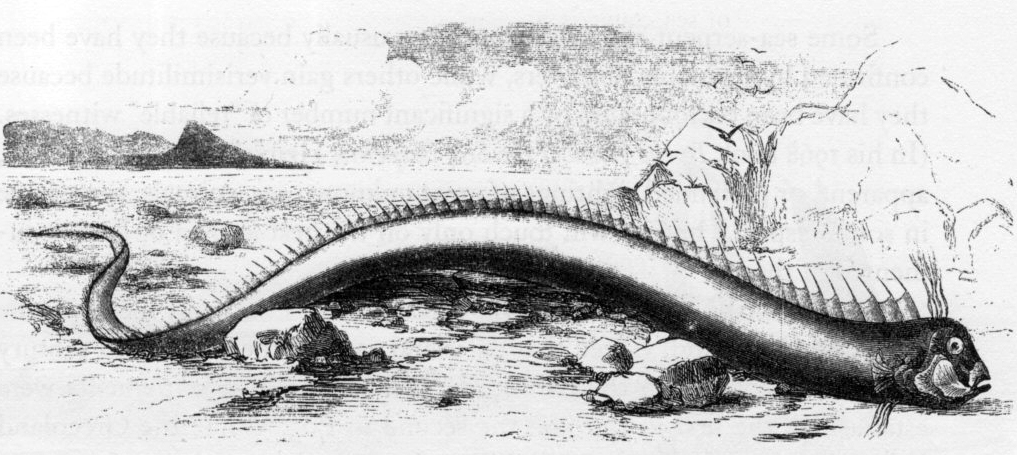The oarfish, scientifically known as Regalecus glesne, remains a captivating subject of intrigue in both marine biology and folklore. This remarkable species can reach lengths exceeding 35 feet, making it one of the ocean’s longest bony fish. Typically found at depths ranging from 656 to 3,300 feet, the oarfish glides elegantly through the water with its ribbon-like body. Its striking appearance, characterized by iridescent scales that shimmer in the light, adds to its enigmatic presence. For many, the oarfish embodies not only the wonders of the deep but also a rich tapestry of legend and superstition.

The legend of oarfish is related to the earthquake.
Throughout history, oarfish have been linked to various superstitions and cultural beliefs, particularly in Japan, where they are famously referred to as “earthquake fish.” According to Japanese legend, the sighting of an oarfish in shallow waters is considered an omen of seismic activity, a belief that can be traced back to the 17th century when the fish was dubbed ryugu no tsukai, meaning “messenger from the sea god’s palace.” Such legends are deeply entrenched in local folklore, often sparking panic and concern whenever reports surface of oarfish sightings.
In an intriguing incident in July, divers off the coast of Ruifang, Taiwan, encountered the oarfish, which sparked a wave of excitement and fear among local residents. The creature’s shimmering body was described as resembling a metallic party streamer, mesmerizing the divers who observed it. However, the oarfish is anything but a typical sea creature; it typically remains hidden at depths inaccessible to most human eyes, and its appearance near the surface raises concerns, triggering the age-old superstitions surrounding it.
The lore surrounding oarfish gained renewed attention following significant seismic events, particularly in 2011 when multiple oarfish washed ashore in Japan prior to one of the most devastating earthquakes in history. Reports of oarfish sightings surged in the aftermath, causing various communities to speculate about their link to earthquakes. The phenomenon has become a hot topic of debate among scientists and folklore enthusiasts alike.
One striking aspect of the oarfish is its behavioral patterns. Deep-sea creatures like the oarfish are inherently elusive due to their preference for darker waters, and their emergence into shallower regions is typically a sign of distress, illness, or disorientation. Researchers, however, caution against jumping to conclusions. There have been numerous anecdotes suggesting animals behave unusually before earthquakes, ranging from frogs to primates. For example, in 373 BC, all animals in the Greek city of Helike reportedly fled prior to a cataclysmic earthquake, showcasing long-standing beliefs in animal instincts as predictors of natural disasters.
Scientific research suggested that the behavior of oarfish was not linked with the earthquake.
Despite the plethora of anecdotal evidence, scientific studies have struggled to establish a definitive link between oarfish appearances and imminent earthquakes. Notably, zoologist Rachel Grant from London South Bank University investigated the behavior of frogs before seismic events but found no supporting evidence for the belief that their swarming behavior indicated forthcoming tremors. Her research highlighted the challenge of differentiating between genuine unusual behavior and normal patterns that may coincide with natural disasters.
Grant’s findings extend to oarfish as well. Alongside a team from Japan’s Tokai University, they examined sightings of oarfish over the past century, ultimately concluding that there is no scientific correlation between their emergence in shallow waters and earthquake activity. The idea of oarfish as a predictor of seismic events is thus categorized more as a myth than as a scientifically supported observation.
Oceanographer Mark Benfield adds another layer to the understanding of oarfish behavior. He proposes that the oarfish’s vertical migrations toward the surface are driven by its search for food, primarily krill. Under normal circumstances, these fish reside in the deep sea, where food sources are abundant. However, changes in environmental conditions, such as shifts in currents or water temperatures, might disorient the oarfish and lead to unintended encounters with humans. This natural behavior is often misconstrued as an ominous sign.
The oarfish also bears witness to the broader theme of how humanity interacts with nature. Its majestic presence captivates those who witness it, yet it also highlights our fears of the unknown. People often seek patterns and explanations in chaotic events, and the oarfish has become a vessel for these anxieties. In an unpredictable world, the notion that an elegant fish could signal impending doom provides a sense of control amid chaos.
As we delve deeper into the enigmatic world of the oarfish, it becomes clear that while its mysterious presence continues to inspire awe and fear, the scientific community urges us to approach such beliefs with skepticism. Understanding the intricate life of the oarfish—its biology, behavior, and environmental needs—offers a more accurate narrative than ancient myths. It serves as a reminder of the wonders of our oceans and the importance of conserving these extraordinary creatures that thrive in the depths, away from humanity’s grasp. The oarfish, rather than being a harbinger of doom, is a symbol of nature’s beauty, complexity, and the need for further exploration and understanding of our oceans. By unraveling the mysteries of the deep and studying creatures like the oarfish, we can foster a greater appreciation for marine life and work toward protecting their habitats from the threats posed by pollution and climate change.
While the oarfish will undoubtedly continue to stir folklore and intrigue, it is crucial to rely on scientific understanding rather than superstition. The stories surrounding the oarfish remind us of the human desire to connect natural phenomena with our experiences. As science progresses, we hold the responsibility of safeguarding our oceans and their inhabitants, ensuring that future generations can marvel at the extraordinary oarfish without the cloud of myth overshadowing its majestic reality.
As we explore the real science behind the oarfish sightings and the lore surrounding earthquakes, it becomes essential to separate fact from myth. The recent resurfacing of oarfish has triggered widespread speculation, evoking a blend of fascination and anxiety among coastal communities. The connection between oarfish appearances and seismic activity is a captivating topic, rich in history and scientific inquiry. To understand this phenomenon, we must delve into various aspects: the biology of oarfish, historical sightings, scientific investigations, and the ongoing debate in the scientific community regarding their significance.
Oarfish prefer to live in the deep sea.
First and foremost, let’s consider the biology of the oarfish itself. Oarfish, known scientifically as Regalecus glesne, are remarkable creatures that inhabit the deep ocean. They can reach impressive lengths, often exceeding 30 feet, and have distinctive, elongated bodies that can shimmer with iridescent hues. This unique appearance allows them to blend seamlessly into their surroundings, making them elusive and rarely seen by the human eye.
Typically dwelling at depths of 656 to 3,300 feet, oarfish are deep-sea dwellers that prefer the dark, cool waters far from the reach of most divers. Their natural behavior involves vertical migrations to feed on krill and other small marine organisms. Scientists suggest that when oarfish are spotted near the surface, it could indicate that they are in distress, ill, or possibly disoriented due to environmental changes.
Despite the absence of scientific validation for the oarfish as an earthquake predictor, the continued intrigue surrounding these creatures speaks volumes about human nature. Our desire to find patterns and meaning in nature’s chaotic behavior is a fundamental aspect of our existence. In a world filled with uncertainties, the idea that an elegant, ethereal fish could serve as a harbinger of impending doom offers a semblance of control over the unpredictable forces of nature.
In recent years, the environmental context surrounding oarfish sightings has gained importance. As climate change and human activities exert pressure on marine ecosystems, deep-sea creatures like oarfish are increasingly affected. Pollution, overfishing, and habitat destruction pose significant threats to their survival. Understanding the ecological dynamics at play is crucial for ensuring the conservation of these magnificent creatures, which may be vulnerable to the very changes that lead them to surface.
As we navigate the complexities of the oarfish’s existence, it is essential to recognize the multifaceted relationship between myth, science, and nature. The stories associated with the oarfish serve as cultural touchstones, reflecting humanity’s intricate connection to the natural world. While science may debunk the notion of oarfish as harbingers of earthquakes, it does not diminish their significance as part of our ocean’s rich tapestry.
The oarfish should be celebrated not as bearers of doom but as spectacular representatives of marine biodiversity. Their awe-inspiring size and unique adaptations to the deep-sea environment warrant appreciation and protection. The more we learn about these elusive creatures, the more we understand the intricate balance of ocean ecosystems and the importance of preserving marine life for future generations.

The relationship between oarfish sightings and earthquakes highlights the fascinating intersection of marine mythology and scientific inquiry. As we investigate these intriguing connections, we cultivate a greater appreciation for the ocean’s hidden wonders. The oarfish transcends its role as a mere mythological figure; it symbolizes the awe and mystery of the deep sea, inspiring us to explore the unknown and safeguard the fragile ecosystems that host such remarkable life. By fostering curiosity and supporting conservation initiatives, we can ensure that future generations will continue to be captivated by the enigmatic beauty of the oarfish and the myriad species that dwell within our oceans.
Related posts:
The Legend of Japan’s ‘Earthquake Fish’
Why are Oarfish Known as Doomsday Fish?
‘Oarfish’ Are Now Resurfacing—and a Superstition Has Some People Worried the ‘Doomsday’ Fish Is a Serious Warning




